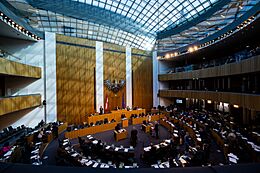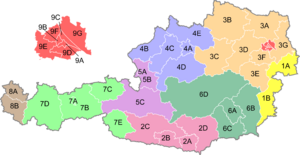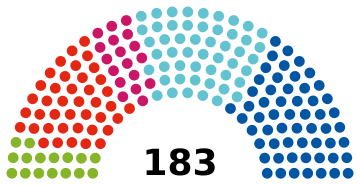Quick facts for kids National Council
Nationalrat |
| 28th Legislative Period |
| Type |
| Type |
|
| History |
| Founded |
10 November 1920 (1920-11-10) |
| Preceded by |
Constituent National Assembly |
| Leadership |
|
President
|
Walter Rosenkranz ( FPÖ)
Since 24 October 2024 |
|
Second President
|
Peter Haubner ( ÖVP)
Since 24 October 2024 |
|
Third President
|
|
| Structure |
| Seats |
183 |
 |
|
Political groups
|
Government (110)
- ÖVP (51)
- SPÖ (41)
- NEOS (18)
Opposition (73)
- FPÖ (57)
- Greens (16)
|
| Elections |
|
|
Open list proportional representation |
|
Last election
|
29 September 2024 |
|
Next election
|
By 2029 |
| Meeting place |
 |
| Austrian Parliament Building, Vienna |
The National Council (called Nationalrat in Austrian German) is like the main decision-making body in Austria. It's one of the two parts of the Austrian Parliament, and it's often called the "lower house." The National Council has much more power than the other part, the Federal Council.
What the National Council Does
The National Council is where most of Austria's federal laws are made. For a new law to be created, the National Council must agree on it.
How Laws Are Made
When the National Council passes a bill (a proposed law), it then goes to the Federal Council.
- If the Federal Council approves the bill, or if they don't do anything for eight weeks, the bill becomes a law.
- If the Federal Council says no to the bill, the National Council can still make it a law. They just have to vote on it again with a stronger majority.
This means the Federal Council usually can't stop laws from being passed.
Special Cases for Laws
There are a few times when the Federal Council can stop a law:
- Laws that limit the powers of Austria's different states.
- Laws that are about the Federal Council's own rights.
- Agreements with other countries that affect the states.
The National Council also needs to approve many important decisions made by the Federal Assembly. For example, if there's a vote to ask the public to remove the President from office, or to declare war, the National Council needs to agree with a two-thirds majority.
How Members Are Chosen

Regional constituencies in Austria. State constituencies are shown in colors.
The National Council has 183 members. These members are chosen by people across Austria in an election that happens every five years. Anyone in Austria who is 16 years old or older on election day can vote.
The Voting System
Austria uses a voting system called "proportional representation" with "partially open lists." This system tries to make sure that the number of seats a political party gets in the National Council is similar to the percentage of votes they received.
Here's a simple way it works:
- Austria is divided into nine main voting areas, which are the same as its states. These areas are then split into 39 smaller local voting areas.
- Political parties create lists of candidates for each local and regional area, and also a list for the whole country.
- When people vote, they choose a party list. They can also choose a specific candidate on that party's list. This means voters have some say in which individual candidates get elected.
- Votes are counted first in the local areas. Seats are given out based on how many votes a party gets compared to the total votes in that area.
- Any votes that don't help a party win a seat at the local level are then counted at the regional level.
- Finally, any remaining votes are counted at the national level to fill the last few seats. A party usually needs at least 4% of the total votes to get seats at the regional or national level.
How Austria's Government Works
Austria's constitution says that the President is in charge of the government. However, in real life, the Chancellor and their team (called the Cabinet) do most of the daily work of running the country. The Chancellor and Cabinet need the support of the National Council to stay in power.
President vs. Chancellor
Even though the President has the power to choose ministers or a Chancellor, they can't keep them in office if the National Council doesn't approve. The National Council can even remove a minister or the whole Cabinet. While the President could technically dissolve the National Council, this power is almost never used.
So, Austria works more like a "parliamentary democracy." This means the government (the Cabinet) is mainly chosen and controlled by the National Council, and the President's role is more symbolic.
The President of the National Council
The constitution says the President of the National Council is Austria's second most important public official, right after the President of Austria. But in practice, the Chancellor is the most powerful political figure. So, the President of the National Council mostly acts as a referee for debates in parliament.
Latest Election Results
Main article: 2024 Austrian legislative election
 |
| Party |
Votes |
% |
+/– |
Seats |
+/– |
|
Freedom Party of Austria |
1,408,514 |
28.85 |
+12.68 |
57 |
+26 |
|
Austrian People's Party |
1,282,734 |
26.27 |
-11.19 |
51 |
–20 |
|
Social Democratic Party of Austria |
1,032,234 |
21.14 |
-0.04 |
41 |
+1 |
|
NEOS |
446,378 |
9.14 |
+1.04 |
18 |
+3 |
|
The Greens |
402,107 |
8.24 |
-5.66 |
16 |
–10 |
|
Communist Party – KPÖ Plus |
116,891 |
2.39 |
+1.70 |
0 |
0 |
|
The Beer Party |
98,395 |
2.02 |
+1.92 |
0 |
0 |
|
Madeleine Petrovic List |
28,488 |
0.58 |
New |
0 |
New |
|
Der Wandel |
27,830 |
0.57 |
+0.11 |
0 |
0 |
|
MFG Austria |
19,785 |
0.41 |
New |
0 |
New |
|
Gaza List |
19,376 |
0.40 |
New |
0 |
New |
|
The Yellows |
156 |
0.00 |
New |
0 |
New |
| Total |
4,882,888 |
100.00 |
– |
183 |
0 |
|
| Valid votes |
4,882,888 |
99.05 |
|
| Invalid/blank votes |
46,857 |
0.95 |
|
| Total votes |
4,929,745 |
100.00 |
|
| Registered voters/turnout |
6,346,059 |
77.68 |
|
| Source: Interior Ministry, ORF |
Results by State

States shaded by the parties' result
| State |
FPÖ |
ÖVP |
SPÖ |
NEOS |
Grüne |
Others |
Turnout |
|
|
|
|
|
| % |
S |
% |
S |
% |
S |
% |
S |
% |
S |
% |
S |
 Burgenland Burgenland |
28.8 |
2 |
28.6 |
2 |
27.0 |
1 |
6.5 |
- |
4.7 |
- |
4.4 |
- |
82.5 |
 Carinthia Carinthia |
38.4 |
4 |
20.8 |
2 |
23.1 |
2 |
7.8 |
- |
4.7 |
- |
5.2 |
- |
76.9 |
 Lower Austria Lower Austria |
29.2 |
10 |
29.9 |
11 |
20.2 |
7 |
8.5 |
3 |
6.7 |
2 |
5.5 |
- |
82.0 |
 Upper Austria Upper Austria |
30.5 |
9 |
26.3 |
8 |
20.3 |
6 |
8.3 |
2 |
8.4 |
2 |
6.2 |
- |
80.1 |
 Salzburg Salzburg |
27.7 |
3 |
31.6 |
3 |
16.8 |
1 |
9.0 |
- |
8.5 |
- |
6.4 |
- |
78.4 |
 Styria Styria |
32.2 |
8 |
27.0 |
7 |
18.6 |
5 |
8.2 |
2 |
7.6 |
2 |
6.4 |
- |
78.5 |
 Tyrol Tyrol |
28.7 |
4 |
31.0 |
4 |
15.4 |
2 |
10.6 |
1 |
8.1 |
1 |
6.2 |
- |
74.3 |
 Vorarlberg Vorarlberg |
27.1 |
2 |
29.1 |
2 |
13.1 |
1 |
12.6 |
1 |
11.4 |
- |
6.7 |
- |
71.8 |
 Vienna Vienna |
20.7 |
6 |
17.4 |
5 |
29.9 |
9 |
11.4 |
3 |
12.3 |
4 |
8.3 |
- |
71.9 |
| Nationwide |
N/A |
9 |
N/A |
7 |
N/A |
7 |
N/A |
6 |
N/A |
5 |
N/A |
- |
N/A |
|
 Austria Austria |
28.8 |
57 |
26.3 |
51 |
21.1 |
41 |
9.1 |
18 |
8.2 |
16 |
6.4 |
- |
77.7 |
| Source: Interior Ministry |
Past Members of the National Council
From 1919 to 1930
|
SDAPÖ |
CS |
German National Movement |
GDVP |
Landbund |
National Economy Bloc (GDVP+Landbund) |
Heimwehr |
Others |
|
Total seats |
| 1919 |
|
170 |
| 1920 |
|
183 |
| 1923 |
|
165 |
| 1927 |
|
165 |
| 1930 |
|
165 |
Since 1945
|
|
Total seats |
| 1945 |
|
165 |
| 1949 |
|
165 |
| 1953 |
|
165 |
| 1956 |
|
165 |
| 1959 |
|
165 |
| 1962 |
|
165 |
| 1966 |
|
165 |
| 1970 |
|
165 |
| 1971 |
|
183 |
| 1975 |
|
183 |
| 1979 |
|
183 |
| 1983 |
|
183 |
| 1986 |
|
183 |
| 1990 |
|
183 |
| 1994 |
|
183 |
| 1995 |
|
183 |
| 1999 |
|
183 |
| 2002 |
|
183 |
| 2006 |
|
183 |
| 2008 |
|
183 |
| 2013 |
|
183 |
| 2017 |
|
183 |
| 2019 |
|
183 |
| 2024 |
|
183 |
Who Is in the National Council Now
Main article: List of members of the National Council of Austria
See also
 In Spanish: Consejo Nacional de Austria para niños
In Spanish: Consejo Nacional de Austria para niños



 In Spanish: Consejo Nacional de Austria para niños
In Spanish: Consejo Nacional de Austria para niños


